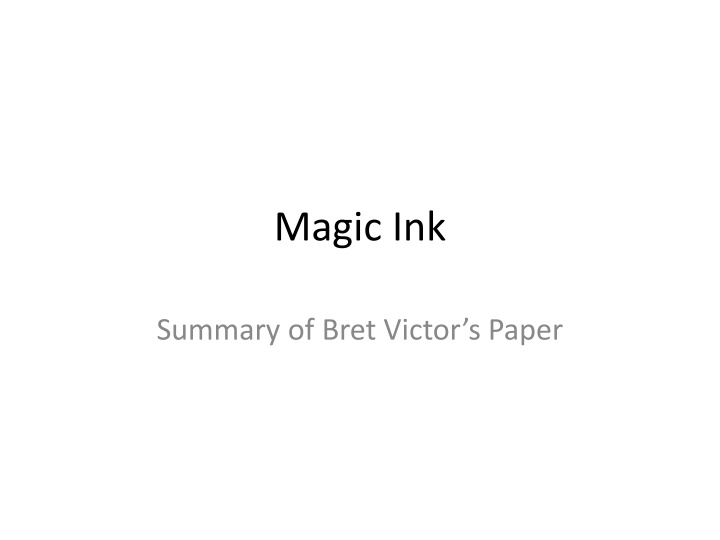
Revolutionizing Information Presentation with Bret Victor's Insights
Explore Bret Victor's groundbreaking ideas on information presentation, focusing on the impact of software on communication and design. Discover how context plays a crucial role in enhancing data visualization and user interaction.
Download Presentation

Please find below an Image/Link to download the presentation.
The content on the website is provided AS IS for your information and personal use only. It may not be sold, licensed, or shared on other websites without obtaining consent from the author. If you encounter any issues during the download, it is possible that the publisher has removed the file from their server.
You are allowed to download the files provided on this website for personal or commercial use, subject to the condition that they are used lawfully. All files are the property of their respective owners.
The content on the website is provided AS IS for your information and personal use only. It may not be sold, licensed, or shared on other websites without obtaining consent from the author.
E N D
Presentation Transcript
Magic Ink Summary of Bret Victor s Paper
Presenting Information Much of Bret Victor s thinking is now in the mainstream. The focus is on how we present and communicate information. And what computing can do to make that communication go better. He distinguishes between information software, communication software and manipulation software. Focus is on information software. His exposition is clear and well-motivated.
What Might People Want to Know? What movies are showing today, at which times? What movies are showing around a particular time? Where are they showing? What are they about? Are they good?
What can software add? The previous redesign is mainly to do with graphics and presentation. So it says what design can do for software. But what can software do for design? Bret Victor says the key is context context is stuff like time, place, history, interest,
What software is good at Software can: infer the context in which its data is needed, winnow the data to exclude the irrelevant, and generate a graphic which directly addresses the present needs. Context is always approximate in some sense. This is qualitatively different from older forms of information presentation.
Summary: Information Software Software design consists of graphic design (drawing pictures) and industrial design (allowing for mechanical manipulation). Information software is for learning an internal model. Manipulation software is for creating an external model. Communication software is for communicating a shared model. Manipulation software design is hard, but most software is information software. Information software design is the design of context- sensitive information graphics. Information software is not a machine, but a medium for visual communication.
Summary: Context Context can be inferred from the environment, which can include physical sensors, other information software, documents created with manipulation software, and data such as email which acts as a user profile. Context can be inferred from a history of past environments and interactions. Last-value predictors provide a rudimentary approach. Learning predictors can infer patterns and make dynamic predictions. Context can be inferred from user interaction, but only as a last resort. The best way to reduce or eliminate interaction is through information-rich graphic design that uses the environment and history. Remaining interaction can be reduced with graphical manipulation, relative navigation, and tight feedback loops.
Summary: Information Software The information software revolution will require public recognition that information software is a medium of visual communication, designers with talent, skill, and tools, simple and general platforms, and an environment that encourages creativity and sharing. A design tool for dynamic graphics that infers behavior from mockups may allow for natural- feeling creative design with no engineering-related distractions. Learning predictors exist and are effective. For them to become widespread, simple abstractions must be invented.
Summary: Less Explicit Interaction An information ecosystem of views and translators may be able to offer relevant information of all forms with minimal interaction. Key aspects include topic nomination and translation, confidence levels, learning through feedback, and a fine-grained modular structure wherein small software providers can thrive. As technology related to graphics, the environment, and history undergoes revolutionary improvements, interaction will become even more of a critical bottleneck. The best approach is to work towards eliminating it. Two centuries ago, Playfair invented statistical graphics and changed the world. The time is ripe for another designer to invent the fundamental context-sensitive graphical forms, and change the world again.
